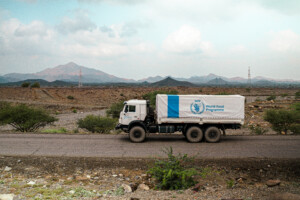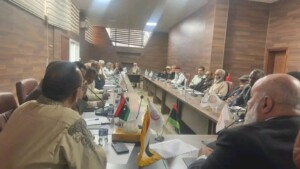Sudan OCHA bulletin 15: New reports of Jebel Marra families in Central, South Darfur
The number of displaced people from the Jebel Marra area in the Sortony internally displaced persons (IDP) site in North Darfur is currently being reviewed by humanitarian agencies, as the International Organization for Migration (IOM) has not been permitted to conduct registration of displaced people in North Darfur since 17 February. Population numbers in areas of displacement can fluctuate significantly upwards or downwards as people move from one location to another, and it is likely the situation in Sortony has changed since the last IOM registration, almost two months ago. Given onward and possible return movement from Sortony over the last two months, and the probable inclusion of resident communities in the Sortony area on initial registration lists, it is presumed that the working figures in Sortony will be significantly reduced in the coming weeks from the previous IOM figure (reported and/or registered) of 68,000 people. The World Food Programme (WFP) is in the process of verifying its distribution figures against those registered earlier in Sortony to ensure current working figures are as accurate as possible. Once this process has been completed, planning figures will be updated accordingly. The Humanitarian Country Team (HCT) and IOM continue to advocate for the resumption of IOM’s registration activities in North Darfur.
The number of displaced people from the Jebel Marra area in the Sortony internally displaced persons (IDP) site in North Darfur is currently being reviewed by humanitarian agencies, as the International Organization for Migration (IOM) has not been permitted to conduct registration of displaced people in North Darfur since 17 February. Also in this bulletin, there are reportedly more than 14,000 displaced people in Central Darfur. 55,400 South Sudanese refugees have arrived in Sudan. Displacement by military and rebel operations in South Kordofan continues.
Population numbers in areas of displacement can fluctuate significantly upwards or downwards as people move from one location to another, and it is likely the situation in Sortony has changed since the last IOM registration, almost two months ago. Given onward and possible return movement from Sortony over the last two months, and the probable inclusion of resident communities in the Sortony area on initial registration lists, it is presumed that the working figures in Sortony will be significantly reduced in the coming weeks from the previous IOM figure (reported and/or registered) of 68,000 people.
The World Food Programme (WFP) is in the process of verifying its distribution figures against those registered earlier in Sortony to ensure current working figures are as accurate as possible. Once this process has been completed, planning figures will be updated accordingly. The Humanitarian Country Team (HCT) and IOM continue to advocate for the resumption of IOM’s registration activities in North Darfur.
Response for new IDPs in Sortony ongoing
Meanwhile, aid organisations continue to respond to the needs of people displaced from Jebel Marra in various locations in the state. Over the past week, 201,177 litres of water were trucked per day to Sortony. The Sudan Emergency Response Framework standard is 7.5 litres per person per day, OCHA reported in March, when the drilling of boreholes was unsuccessful. Now, displaced people are able to collect about 65,000 litres from local boreholes per day.
A recent geophysical survey identified several potential borehole sites and the African Union – United Nations Mission in Darfur (UNAMID) will start on drilling two boreholes on 14 April. The UN Children’s Agency (UNICEF) is planning to dispatch a drilling rig from El Fasher on 13 April. So far, 800 latrines have been constructed, 500 by UNICEF and 300 by the international NGO Oxfam. An additional 700 latrines are under construction by Oxfam.
The WFP is in the process of verifying its distribution figures against those registered in Sortony. Health and nutrition services in three clinics in Sortony receive from 190 to 210 people on a daily basis.
The national NGO ANHAR—in collaboration with WFP—plans to open a targeted supplementary feeding programme in the area. There are also three child-friendly spaces in the area, which have been serving 621 children in the morning session and 726 in the evening session. Two nutrition centres will be opened in the area. WFP has already dispatched ‘ready to use supplementary food’ (Plumpy Sup) for treatment of moderate acute malnutrition (MAM) and emergency blanket supplementary feeding programme targeting children under five and pregnant and nursing women.
In Tawila, the number severe acute malnutrition (SAM) cases admitted to nutrition centres have doubled since last week. International NGO Médecins Sans Frontières – Spain (MSF-E) reported 191 new admissions to nutrition centres during the last two weeks with a total of 388 cases admitted in nutrition centres so far. The deterioration of the nutrition situation has been linked to the high number of diarrhoea cases and respiratory infections reported. To respond to the increasing caseload of severe acute malnutrition, the State Ministry of Health has opened new outpatient therapeutic program (OTP) centre in Tawila.
According to IOM, current water availability in Tawila is 336,000 litres per day. WES and IOM have started digging a borehole and installing two elevated water tanks in the area. IOM—through the national NGO National Planning Organization (NPO) and Plan Sudan—have built 70 latrines and rehabilitated 200.
Over 14,400 displaced from Jebel Marra in Central Darfur, HAC
According to the Government’s Humanitarian Aid Commission (HAC), the number of IDPs in Central Darfur now stands at 14,439, an increase of about 70 people from what was reported last week. This increase is mainly in Hassahissa camp where people arrived from Sortony. There are also reports from local sources of the continuous arrival of people in Thur, Guldo and Nertiti.
According to HAC, on 1 April local authorities relocated about 750 newly displaced people from Golo to Guldo due to security concerns, with about 60 newly displaced from Jebel Marra currently left in Golo town. In addition, there are also reports from community leaders in Guldo of insecurity in the area, with people reportedly leaving Guldo to Nertiti town. Aid organisations are unable to confirm this due to lack of access. Authorities and aid organisations continue to provide humanitarian assistance to the people displaced from Jebel Marra in the state.
According to HAC, authorities have distributed food—including sorghum and dates—blankets, jerry cans as well as women’s and children’s clothing to Jebel Marra IDPs in Nertiti, Thur and Guldo towns. A further assessment of food needs (oil and pulses) is planned to take place soon.
In Nertiti town, the international NGO Islamic Relief Worldwide (IRW) is undertaking water and sanitation interventions. Authorities continue to deny international humanitarian actors access to new IDPs in Nertiti, Thur, Guldo and Golo as well as in other areas of displacement in the state. Subsequently, there is no Area/HCT confirmation of displacement numbers and humanitarian needs in these locations. Advocacy on access continues at state and federal levels.
HAC: displacement from Jebel Marra into South Darfur continues
n Kass IDP camp, there are now 756 families taking refuge in the camp from the Jebel Marra area. From 29 March to 5 April, WFP conducted a rapid food security assessment of the new arrivals in the town. Findings indicated that most of their food stocks had been either left behind, burned during the conflict or were looted. This year the lean season has started earlier than usual, cereal prices have increased due to the poor harvest, and job opportunities are lower than usual. As a result of all these factors, the food security of the new arrivals is very poor.
People have also fled East Jebel Marra and have arrived in various localities in South Darfur State. In Nyala locality, 322 families have arrived in Otash camp. Many of these displaced had initially been taking refuge with relatives in Nyala town but started moving into Otash as of 31 March. According to the new arrivals, more people are expected to arrive soon.
In Alwehda locality, 180 families have arrived in Malam town, while about 236 families have reportedly arrived in different locations in Marshang locality. IOM will be sending verification teams. International humanitarian actors still do not have access to areas in eastern Jebel Mara, including Deribat, to verify the number of new displaced and to identify needs. Advocacy on access continues at state and federal levels.
About 55,400 South Sudanese arrive in Sudan
Since late January, an estimated 55,400 South Sudanese have arrived in East and South Darfur, as well as West Kordofan, according to aid organisations. Food insecurity relating to conflict in South Sudan, as well as a poor agricultural season and high cereal prices are believed to be the main drivers. UNHCR, together with other UN agencies and partners is working on a preparedness plan for up to 120,000 South Sudanese arrivals in East and South Darfur, as well as West Kordofan, covering the period of April to June 2016.
OCHA is supporting UNHCR with refugee response in East Darfur, where the latter does not yet have a permanent presence, and advocacy efforts are underway to allow UNHCR to expand its presence in the state.

East Darfur hosts 77 percent of new arrivals from South Sudan
East Darfur hosts the majority (77 percent) of all the new South Sudanese arrivals, most of whom have taken refuge in Khor Omer camp. By 11 April, IOM has registered 24,944 new South Sudanese in the camp. This number is about 4,000 less compared to the figure reported last week.
Meanwhile, according to the registration team, the daily arrival rate has decreased with about 264 people arriving in the camp daily between 3 – 9 April. In response to the needs of newly arrived South Sudanese, the State Ministry of Health (SMoH)—with UNICEF support—carried out a measles vaccination campaign from 4-7 April reaching 1,935 children between nine months and 15 years.
Response to new South Sudanese arrivals in Bileil camp, South Darfur
On 7 April, UNHCR—through the international NGO Norwegian Church Aid (NCA)— distributed emergency household supplies to 4,047 new South Sudanese in Bileil camp. WFP has started the distribution of food for the new arrivals on 11 April. Arrivals in West Kordofan’s Kharasana and El Meiram areas HAC reported 10,075 South Sudanese have arrived in West Kordofan’s Kharasana and El Meiram areas since February, including 4,920 people in Kharasana and 5,155 in El Meiram. In El Meiram, an overall acute malnutrition rate of 34 per cent for children under five was found following a UNICEF supported screening of arrivals in the area. Out of 556 children screened, 43 (7.7 per cent) had SAM and 147 (26.4 per cent) had MAM.
Civilian displacement in South Kordofan – HAC
According to HAC, civilians are fleeing their homes following fighting between government forces and the Sudan People’s Liberation Movement – North (SPLM-N) in the state. The displaced people are arriving in Rashad, El Abassiya and Abu Jubaiha localities. While about 720 newly displaced people have been reported, more are expected to be displaced over the coming days as fighting continues, according to HAC.
In Rashad locality, the national NGO Global Aid Hand (GAH) reported the arrival of 263 people (47 families) in El Dweim, Dargasha and Gortange El Gadeema villages in Rashad locality from Arkala village on 7 April. In El Abassiya locality, HAC reported the arrival of 423 people (80 families) in Souk El Jabal area from Toro, Taha and Tula villages from 4 – 6 April.
In response, UNICEF provided one primary health care kit—enough to cover the needs of 10,000 people for one month—to the SMoH for the newly arrived people in Souk El Jabal. There is a new health facility in Souk El Jabal but it has yet to be equipped. The SMoH is planning to send furniture, medical equipment and a medical assistant to the new health facility. In addition, the international NGO Concern Worldwide (CW) has sent 80 emergency household kits for the new IDPs in Souk El Jebel.
In Abu Jubaiha locality, HAC also reported the arrival of 30 people (10 families) in Gedeid village from Kau Niaro village. These people are reportedly in need of food as well as emergency shelter and household supplies. Local authorities will relocate these people— as well as the 300 families expected to arrive soon—to Elsahal village.
Joint Troika statement on the AUHIP Roadmap
On 8 April, the Governments of the United States of America, the United Kingdom, and Norway issued a joint statement encouraging Sudanese Parties to agree to a Roadmap Agreement by the African Union High-level Implementation Panel (AUHIP) for ending conflict in Sudan. If agreed to by all parties to the conflicts, the AUHIP Roadmap could allow genuine political dialogue at both regional and national levels that is needed to address the underlying causes of the armed conflicts that have plagued Sudan for so long, the statement said.
The US, UK and Norway governments expressed deep concern about the increase in fighting between Government forces and the SPLM-N in both Blue Nile and South Kordofan and urged both sides to show restraint and avoid ambushes, military offensives, rocket attacks, and aerial bombardments that negatively affect civilian populations. Humanitarian needs in Sudan are predominantly caused by armed conflict which, in turn, drives displacement and food insecurity











 and then
and then